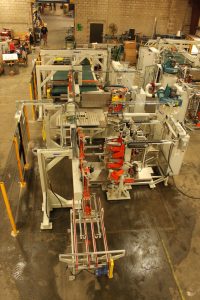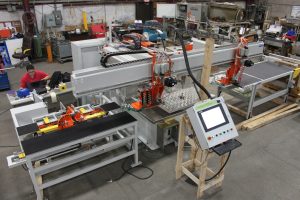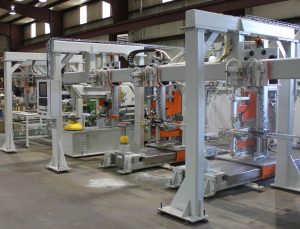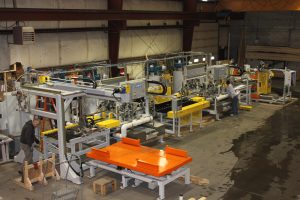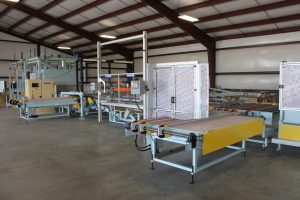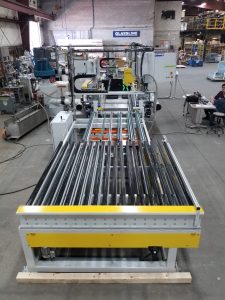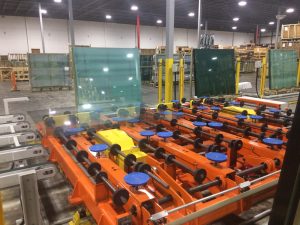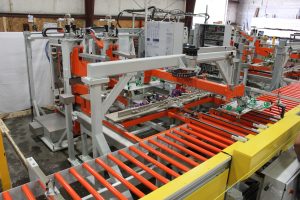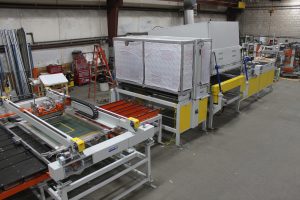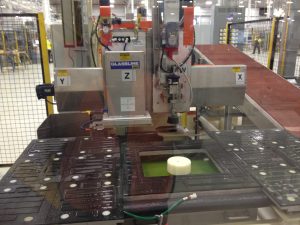AUTOMATIC GLASS PROCESSING LINE
The glass processing line is an important automatic system in the glass industry, ensuring the processing of high quality glass products. Below are examples of some complete glass processing lines.
CNC PRE-PROCESSING LINES (Grind, Drill, Cut, Break)
CBG (Cutting, Breaking, Grinding and Drilling) glass processing lines are comprehensive pretreatment line solutions commonly used for automotive style glass. This line will be the size of a flat block of glass and produce a part form with appropriately ground edges and holes. There are several configuration options for these lines. But typically, each line of the block is set to cut out a single form. Common line arrangements include:
– Turntable to automatically switch racks
– CNC punching cutting machine
– CNC grinding machine
– Automatic drilling machine
– Automatic wheel loader
– Vacuum brush
– Shuttles vary from machine to machine
Sometimes sidelites have additional machinery, called “cross cutters”, to split the block in half before the CBG line.
CNC CUTDOWN LINE WITH AUTOMATIC BREAKING (APPLIANCE)
The entire processing line, which includes automated loading, cutting, and breaking, for the appliance industry. A single block was divided into many shaped pieces, and the block as a whole was then mechanically split out. The forms were restricted to radius corners to some extent, but the line was still complicated since the shape breakout required a large amount of automation to modify the breakout motions for each individual component.
CNC GRINDING SYSTEMS (AUTOMATED SQUARING & LOAD/UNLOAD)
This solution was a whole line for grinding glass for unique appliances, but it may also be used for furniture, cars, and other things. To cut down on part-to-part cycle time, think about loading into a reference station rather than a manually operated gantry machine. A shuttle carefully feeds the item into a CNC grinder from the reference station, and subsequently unloads it into the washer.
CNC GRINDING AND MULTIHEAD DRILLING SYSTEMS
APPLIANCE (RECTANGLE) PROCESSING LINES(LOAD/EDGE/DRILL)
An example of a completely automated appliance glass processing line is the one displayed. Included were two-hole in-line drilling, corner radiusing, automated loading, double edge grinding with grooving and high-speed corner dubbing. Different solutions were provided for additional lines, one of which being the mitered corner grinding and cutting.
SILKSCREEN PRINTING AND DRYING SYSTEMS
This line had to handle a wide variety of intricate sidelite and quarterlite forms. It would be difficult and need a lot of changeover time to implement a mechanical squaring method. By only loading a new file, the vision system enables the operator to switch between tasks quite quickly.
This processing line includes:
– Loading the line robotically
– Cleaning
– The printing machine’s vision/robot loading
– Silkscreen printer with a maximum resolution of 800×1200; minuscule quarterlite parts may be produced in as little as 4 seconds per item.
– The system includes an XY suction, offline visual inspection, and automated reject processing.
– Accumulators, pass-through conveyors, and other belt/roll conveyors and transfers are used for drying.
Even bigger Windshield printing and drying operations have utilized similar methods.
AUTO LOAD AND SLITTING LINE TO FEED DOUBLE EDGER
Manufacturers of appliances and various other products must process tiny pieces for items like refrigerator shelves. If the raw glass is delivered in tiny fragments from the float line, it is more expensive and challenging to handle. Thus, one way to solve the problem is to use a slitting line, which allows glass to be transported in bigger blanks and then cut down or sliced into the necessary tiny pieces.
In the example shown, the top loader automatically loads the block and positions it so that the slot pieces have nominal size tolerances. Then, the glass plate is moved below the five-headed canal bridge. The application will automatically adjust these heads to the appropriate size depending on the ingredients and desired block size. The glass is then moved, the score is broken, and the separate pieces are sent into the double cutter.
DOUBLE EDGES/SEWING AND SERIES CREATION IN GLASS PROCESSING
Addition to having an operator loading the conveyor to feed into the furnace, the joining line solved the manpower problem by joining all the parts in a much shorter time, while also automatically loading rows of parts into the flat quenching furnace.
JUMBO AND SEMI JUMBO LOADING AND CUTTING SYSTEMS
CNC cutting machines need to provide the most optimal speed, acceleration and tolerances. This speed must be met by a suitable loading system. Semi-jumbo loaders are a good choice for systems that require few types of glass.
CNC MULTI-HEAD XY DRILLING SYSTEMS WITH AUTO LOAD/UNLOAD
This glass processing line exemplifies a fully automatic inline drilling system that can drill multiple holes and pieces at the same time or consecutively. This product line has two drilling systems, each with two drilling heads. After the glass is squared by the input conveyor system, a second arm carries the drilled part to the output conveyor line and the servo rotation assembly picks up the new part and delivers it to the drill. The drill’s separate X-axis allows two holes to be drilled simultaneously as the table moves along the Y-axis.
Robotnext can provide drilling systems with a variety of configurations, please contact us for free consultation.
ROBOT LOADING AND CNC CUTDOWN LINES
When complicated applications call for it, robotic loading offers the highest level of flexibility. Robotnext can design your large glass unloading solution via robot and automatically transfer it to the CNC cutting machine.
PRINT, DRY, SQUARING – IN-LINE WITH FURNACE
The bending and tempering furnace was positioned next to a semi-automated screen printing machine and dryer. It was also asked for a 20-piece accumulator. Before the glass went into the furnace, it had to be exactly squared to fit the tools. Systems for printing, drying, and loading furnaces can be designed in a variety of ways.
WATERJET_GRINDING HOLE-IN-GLASS PROCESSING LINE
In order to satisfy the demands of the new “hole-in-glass” goods emerging from the automobile industry, as for the F150, Waterjet_Grinder was created in 2018. This procedure has never been carried out before. The completely automated line was created by Glassline, and it was a huge success. The mechanism was designed to accommodate cuts up to around 24×24. More machines have been made for a wider range of items.
LAMINATED AUTOMOTIVE GLASS DE-AIRING LINE(NIPPER LINE)
In this glass processing process, Curved laminated automobile components are commonly produced on the Windshield and/or S/L De-Airing Lines, also known as the Nipper Line or Tacking Line. The press rollers compress the two layers of glass and the PVB interlayer, creating a “sandwich”.
Usually, there are two sets of presses in the line. The purpose of the first press is to remove the majority of the air from the sandwich, while the second press completes the de-airing process and securely “tacks” the glass and vinyl together so that they may be handled before being sent downstream to an autoclave. Depending on the kind of glass to be processed—windshields or sidelites and the greatest size that can be processed, the Nipper presses can have a variety of forms and widths.
If you are interested in automating glass processing into your glass production process or would like to know more about how to improve production efficiency, contact us today for consultation and cost support. Details via Hotline: 0909 914 837.
Other reference applications:


